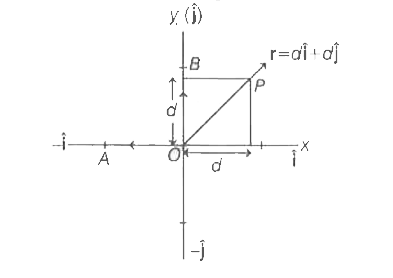Two infinitely long straight wires A and B, each carrying current I are placed on x and y-axis, respectively. The current in wires A and B flow along −ˆi and ˆj directions respectively. The force on a charge particle having vharge q, moving from position, r=d(ˆi+ˆj) with velocity v=vˆi is Solution in Telugu
μ0lqv2πdˆj
μ0lqvπdˆj
μ0lqv√2πdˆk
0
The correct Answer is:B
The given situation for two curent carying wires are shown in the figures.

Position vector of charge particle,
r=d(ˆi+ˆj)=dˆi+dˆj
The magnetic field intensity due to the wire along −ˆi direction,
B1=μ02π.Id(−ˆk)
Similarly, magnetic field intensity due to wire along ˆj direction.
B2=μ02π.Id(−ˆk)
∴ Resultant magnetic field at point P due to both the wires,
B=B1+B2=2.μ02π.Id(−ˆk)
B=μ0π.Id(−ˆk)
∴ Force on the charged particles.
F=q(v×B)=q[vˆi×μ0πId.(−ˆk)]=μ0Iqvπd.ˆj
Topper's Solved these Questions
Similar Questions
A tokamak fusion test reactor works on
02:14View SolutionWhich of the following represents fundamental forces of nature ?
04:15View SolutionThe position vector of point C with respect to B is hat i+hat j and that of B with the respect to A is hat i-hat j .The position vector of C with respect to A is
01:27View SolutionIf hat i and hat j are unit vectors along X - and Y -axis respectively,then what is the magnitude and direction of hat i+hat j and hat i-hat j?
01:25View SolutionA charged particle moves with velocity vec v = a hat i + d hat j in a magnetic field vec B = A hat i + D hat j. The force acting on the particle has magnitude F. Then,
02:25View SolutionAssertion: If hat(i) and hat(j) are unit Vectors along x-axis and y-axis respectively, the magnitude of Vector hat(i)+hat(j) will be sqrt(2) Reason: Unit vectors are used to indicate a direction only.
02:25View SolutionA charge particles q enters in a magnetic field vec(B)=y hat(i) + x hat (j) with the velocity vec(v)= x hat (i) y hat (j) . Neglect any force other than magnetic force. Now answer the following question. Magnetic force F acting on charge is proportional to –
07:29View SolutionA charge particles q enters in a magnetic field →B=yˆi+xˆj with the velocity →v=xˆiyˆj . Neglect any force other than magnetic force. Now answer the following question.
Which of the following is true for the direction of magnetic force ?01:03View Solutionयदि ˆi,ˆj,ˆk क्रमशः X,Y,Z अक्ष की दिशा में एकांक सदिश हो तो सिद्ध कीजिये -
(a) ˆi⋅ˆi=ˆj⋅ˆj=ˆk⋅ˆk=1
(b) ˆi⋅ˆj=ˆi⋅ˆk=ˆj⋅ˆk=0
(c) ˆi׈i=ˆj׈j=ˆk׈k=002:41View Solutionˆi,ˆj तथा ˆk क्रमशः X,Y तथा Z-अक्षो की दिशा में एकांक वेक्टर है गुणनफल (ˆi׈j) बराबर होगा -
View SolutionIf ˆi,ˆjandˆk are unit vectors along x,y and z-axis respectively, the angle θ between the vector ˆi+ˆj+ˆk and vectorˆj is given by
05:13View SolutionTwo infinitely long straight wires A and B , each carrying current I are placed on x and y axis respectively. The current in wires A and B flow along −ˆi and ˆj directions respectively. The force on a charged particle having charge q moving from position →r=d(ˆi+ˆj) with velocity →v=vˆi is
03:56View Solutionˆi व ˆj क्रमशः X व Y अक्षो के अनुदिश एकांक सदिश है |सदिशों ˆi+ˆj तथाˆi−ˆj का परिणाम तथा दिशा क्या होगा ?
02:09View Solutionयदि ˆi,ˆj,ˆk क्रमशः X-अक्ष Y- अक्ष और Z-अक्ष के अनुदिश इकाई सदिश है , तो ˆi×(ˆj׈k) का मान होगा -
02:57View SolutionAssertion: If ˆi and ˆj are unit Vectors along x-axis and y-axis respectively, the magnitude of Vector ˆi+ˆj will be √2
Reason: Unit vectors are used to indicate a direction only.03:16View Solution

